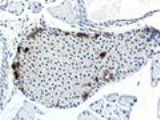
Pancreatic polypeptide
Encyclopedia
Pancreatic polypeptide is a polypeptide secreted by PP cell
s in the endocrine pancreas predominantly in the head of the pancreas. It consists of 36 amino acids and has molecular weight about 4200 Da.
The function of PP is to self regulate the pancreas secretion activities (endocrine and exocrine), it also has effects on hepatic glycogen
levels and gastrointestinal secretions.
Its secretion in humans is increased after a protein meal, fasting, exercise, and acute hypoglycemia
and is decreased by somatostatin
and intravenous glucose
.
PP cell
F cells are pancreatic polypeptide producing cells in the islets of Langerhans in the pancreas. They are very few in number and are polygonal in shape....
s in the endocrine pancreas predominantly in the head of the pancreas. It consists of 36 amino acids and has molecular weight about 4200 Da.
The function of PP is to self regulate the pancreas secretion activities (endocrine and exocrine), it also has effects on hepatic glycogen
Glycogen
Glycogen is a molecule that serves as the secondary long-term energy storage in animal and fungal cells, with the primary energy stores being held in adipose tissue...
levels and gastrointestinal secretions.
Its secretion in humans is increased after a protein meal, fasting, exercise, and acute hypoglycemia
Hypoglycemia
Hypoglycemia or hypoglycæmia is the medical term for a state produced by a lower than normal level of blood glucose. The term literally means "under-sweet blood"...
and is decreased by somatostatin
Somatostatin
Somatostatin is a peptide hormone that regulates the endocrine system and affects neurotransmission and cell proliferation via interaction with G-protein-coupled somatostatin receptors and inhibition of the release of numerous secondary hormones.Somatostatin...
and intravenous glucose
Glucose
Glucose is a simple sugar and an important carbohydrate in biology. Cells use it as the primary source of energy and a metabolic intermediate...
.
External links
- BBC Hope over 'obesity-busting gum' 15 January 2007

